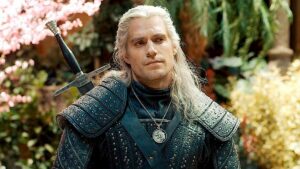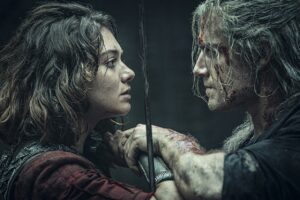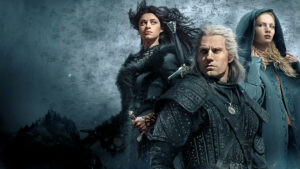Netflix’s “The Witcher” – Magic is Female

Title: “The Witcher” (“Wiedźmin”)
Release Date: TV series 2019
Cast: Henry Cavill, Anya Chalotra, Freya Allan, Joey Batey, Jodhi May
One of the most anticipated Netflix premieres of 2019 is now behind us. In Poland, the serial adaptation of Andrzej Sapkowski’s The Witcher saga had the bar set very high. Fans of the five-book and White Wolf stories alternated between dreams of a screen adaptation on the scale of Game of Thrones and predictions of total disaster. Neither happened. “The Witcher” is not a masterpiece, but it’s not a failure either. The series is also a kind of surprise: the power of this film rests in the hands of women who tempt, delight and terrify at the same time.
“The Witcher” – the whole thing to fold
What rules the world – chaos or destiny? Is there a lesser and a greater evil? Does otherness have a chance to be accepted? These and other philosophical questions present in Andrzej Sapkowski’s prose also resound very clearly in the Netflix series. And it’s a good thing too, because they give the story of “The Witcher” a deeper, metaphorical meaning. The initial sequences of the film, when two different orders – the world of monsters and the world of humans – collide, provide food for thought. The hero kills a dangerous kikimora, only to encounter hostile rejection and human contempt a moment later in an inn. It turns out that the Witchers, mutants who fight monsters, are treated as deplorable misfits. And that Other is Gerald of Rivia (played by Henry Cavill), the famous White Wolf, whose fate is gradually revealed in the subsequent parts of the eight-episode season.
Of course, otherness has many different faces in The Witcher’s world. Elves, wizards, dwarves or simply people with some sort of disability are also different. And paradoxically, it is them, cruelly experienced by fate, who fight against their own destiny, questioning the existing world order. The Witcher, for instance, learns what love is, despite the emotional mutation of which he is accused, while Yennefer wants to reverse the effects of her magical metamorphosis. On the other hand, the changelings remain faithful to their fate, such as the Law of Surprise, which is invoked several times, and under which the Witcher’s fate is tied to Cirilla, Princess of Cintra.

The creators of the series combined the themes present in Sapkowski’s stories with the plot of the five books. On the one hand, it was a good idea, because the material became much richer, but on the other hand, certain difficulties could not be avoided. If, for example, I had not read the Witcher stories, the numerous time jumps in the story would have been completely unclear to me. The thread of Cintra’s fall and Cirilla’s story was not only shown backwards, but also bizarrely shuffled with other distant events in time without any sign of flashbacks.
Admittedly, it should be added that in the final episode of the series all the pieces of the puzzle neatly come together and the idea of the whole story is revealed, but I have a feeling that for a viewer unfamiliar with Sapkowski’s prose, this can make the reception of the book much more difficult. It also seems that some plots have been overdone, others have been shortened too much, and the humour, so characteristic of Sapkowski’s work, is a little weak in the initial episodes. On the other hand, there is no shortage of real gems: Yennefer’s well-developed and coherent plot, the brilliant battle scenes, and the suspenseful defense of Soddom. Another unquestionable asset of “The Witcher” are the well-written characters reflected in the good acting. Apart from the main characters, the one who deserves special praise is Jasker (Joey Batey), a romantic bard who brings an invigorating breath of good humor to the series in various forms – characters, words and situations. In a word, the season stands up as a whole, but there is one condition: you must persevere to the end.
“The Witcher” – women’s strength and women’s weakness
The greatest strength of Netflix’s “The Witcher”, however, are the women – as film characters and as actresses. They give rhythm to the whole story and become the viewers’ guides through the fantastic world, just like Renfri was for Gerald in the first episode of the series. It is no coincidence that the meeting with the woman sets the action of “The Witcher” in motion and forces the protagonist to break out of his dark reverie about his complicated fate. Besides, every time a female character appears in the frame, the film almost comes to life and the plot begins to move forward gracefully.

For me, without a doubt the best performance in the series is the role of Calanthe, bravely played by Jodhi May. The Queen of Cintra is a woman who combines beauty and courage with true cruelty and cunning. The image of the Lioness of Cintra in armor with her hair disheveled is visually reminiscent of Joan of Arc or Queen Elizabeth of the Tudor dynasty. However, she is far from virtuous and cool heroines. Calanthe from The Witcher is a volcano of passion. Her ironic, sharp wit, erotic appetite and fencing skills surpass most men in the kingdom. In one scene, Calanthe also speaks to her granddaughter Cirilla in significant words that go something like this: “life is like war. You never know when you will be attacked. So always keep your sword close and keep coming forward.
The plot of Yennefer (Anya Chalotra) was very well built in the series. By showing her painful fate as a crippled girl rejected by her own parents, the character has gained a clear motivation and consistent personality. Yennefer is convincing as a woman who has had everything taken from her and greedily demands “everything” from the world – as she exclaims to her teacher in one scene. The price for “everything,” however, is a steep one. And Yennefer pays it.
She convinces Cirilla (Freya Allan) as a girl who loses her loved ones and must mature very quickly, fighting for survival at all costs. She then activates layers of secret power within herself, the existence of which she did not even suspect. Also worth mentioning is Triss, a beautiful fairy who, despite her ethereal stature, courageously takes the right side and fights to the end at Sodden. On the other side of the barricade is Fringilla (Mimi Ndiweni), a cruel witch who controls the ruler of Nifgaard as if she were a helpless puppet.

In “The Witcher”, the power is undoubtedly female. And it’s not only about the power of physical charms. Yes, each of the heroines has an appealing beauty, but she can also be a tool of power – in the erotic sphere. The feminist theme is strongly emphasized in the series, and what’s more, by expanding the female sequences, the creators of the series perfectly reflected the spirit of Sapkowski’s prose. In Sapkowski’s works, women have attributes attributed to men: they are strong, sexually liberated, and in control.
Nevertheless, only sorceresses and queens enjoy such a privileged position. Thus, the bitter clash between Yennefer’s fate as a lonely hunchback and her reincarnation as a glamorous sorceress is electrifying. What’s more, the transformation is the film’s masterpiece. The filmmakers have ingeniously combined the ghoul story from “The Witcher” with Yennefer’s metamorphosis. The ghoul that Geralt battles is actually a helpless girl who has been cursed. Yennefer’s transformation is analogous and equally ambiguous – it is unclear whether the human is turning into a monster or vice versa. Or perhaps the bright line between good and evil becomes blurred for good, and evil gains a variety of shades?
It is no coincidence that Yennefer, while burying a dead infant girl, utters a telling statement about women’s plight: she says that all women are merely “vessels” from which everyone draws until they are completely empty and useless. The protagonist’s anger stems from her rebellion against this order of things and eventually finds vent.
